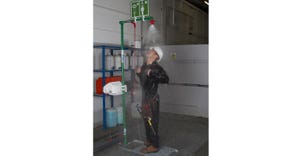Measurement and Monitoring of Coal and Biomass Handling Processes
October 20, 2016

Coal- and biomass-fired power stations are burning an increasingly diverse range of fuels and fuel blends of varying composition and combustion properties, under tight economic and environmental constraints. The recent trend in operating power plant in variable load in response to changes in electricity demand has exacerbated a range of technological problems in the power industry. To meet the increasingly stringent standards on combustion efficiency, pollutant emissions and renewables obligations and to maintain fuel flexibility, measurement and monitoring techniques have become highly desirable in the power industry.
In coal/biomass-fired electrical power generation the fuel is supplied from a bunker into a pulverizing mill and the pulverized fuel is then pneumatically conveyed towards a wall-fired or a tangentially fired furnace through a fuel distribution pipe network. Advanced sensors and instrumentation techniques for on-line continuous measurement and monitoring of fuel storage units, fuel bunkers, pulverizing mills and fuel distribution pipes have been regarded as a priority technological development by leading power generation organizations and research institutions. This trend is further enhanced by the increasingly stringent safety requirement, emissions legislations, better plant maintainability and increased fuel flexibility.
The coal and biomass handling system in power generation can be divided into several individual processes that are interconnected to each other from fuel storage to the furnace. Each process requires on-line continuous measurement or monitoring for different reasons. The monitoring issues are concerned with fuel storage (spontaneous ignition and fire detection), fuel bunkers (fuel level measurement), pulverizing mills (fuel level measurement and mill condition monitoring) and pulverized fuel injection systems (fuel flow metering and on-line particle sizing). The measurement and monitoring techniques are aimed not only to achieve the optimization of existing power plants but also to provide a useful reference for the specification and design of new build installations.
There have been significant advances in developing techniques for the sensing and measurement of coal and biomass handling processes. However, many techniques are still to be developed to meet some of the challenging industrial measurement requirements. For instance, the low ignition temperature of biomass has increased the risk of fire at biomass power plant, so the continuous temperature profiling of biomass fuels has become essential for safety reasons. Plant operators have used conventional devices such as an array of thermocouples to gain the crude profile of a biomass site, but such devices are intrusive and often moved away from their original location or even ripped out during fuel loading or unloading. A non-intrusive, three-dimensional, cost-effective temperature profiling system for stored biomass is currently being developed. Fuel bunker monitors based on radar, ultrasonic, laser sensors for continuous level monitoring are available on the market. Such monitors need to withstand hostile environments such as high dust, wide fluctuations in ambient temperature and humidity, and varying fuel properties.
Pulverizing mill monitoring is achieved through the use of acoustic emission or vibration sensors incorporating signal analysis algorithms or data models. Apart from the measurement of fuel level in the mill, the monitoring system should also be able to predict pocket fires particularly in the co-milling of biomass and coal and during mill start-ups and shutdowns as well as an indication of the overall operating condition of the mill.
There have been some successes in recent years in deploying electrostatic sensing techniques for pulverized fuel flow metering and developing acoustic emission techniques for the on-line continuous size measurement of coal and biomass particles. However, the co-combustion of biomass with coal will mean that fuel flow metering and on-line particle sizing are likely to be more challenging in view of the complex nature of coal-biomass-air three-phase flow. Wood pellets are a common fuel, which often contains fine wood-dust presenting a potential explosive hazard. Meanwhile the presence of a small fraction of wood pellets in wood-dust in biomass pipes directly feeding the furnace creates combustion problems. It is thus desirable to measure the size distribution of wood pellets and fine particles in an on-line continuous manner. Acoustic sensors coupled with signal processing algorithms have been applied successfully to detect the presence of wood pellets in wood-dust and hence the optimized control of elutriators.
Yong Yan is Professor of Electronic Instrumentation and Director of Research at the School of Engineering, University of Kent, Canterbury, UK.
Click here for information about the Powder & Bulk Solids Montreal Showcase
You May Also Like


